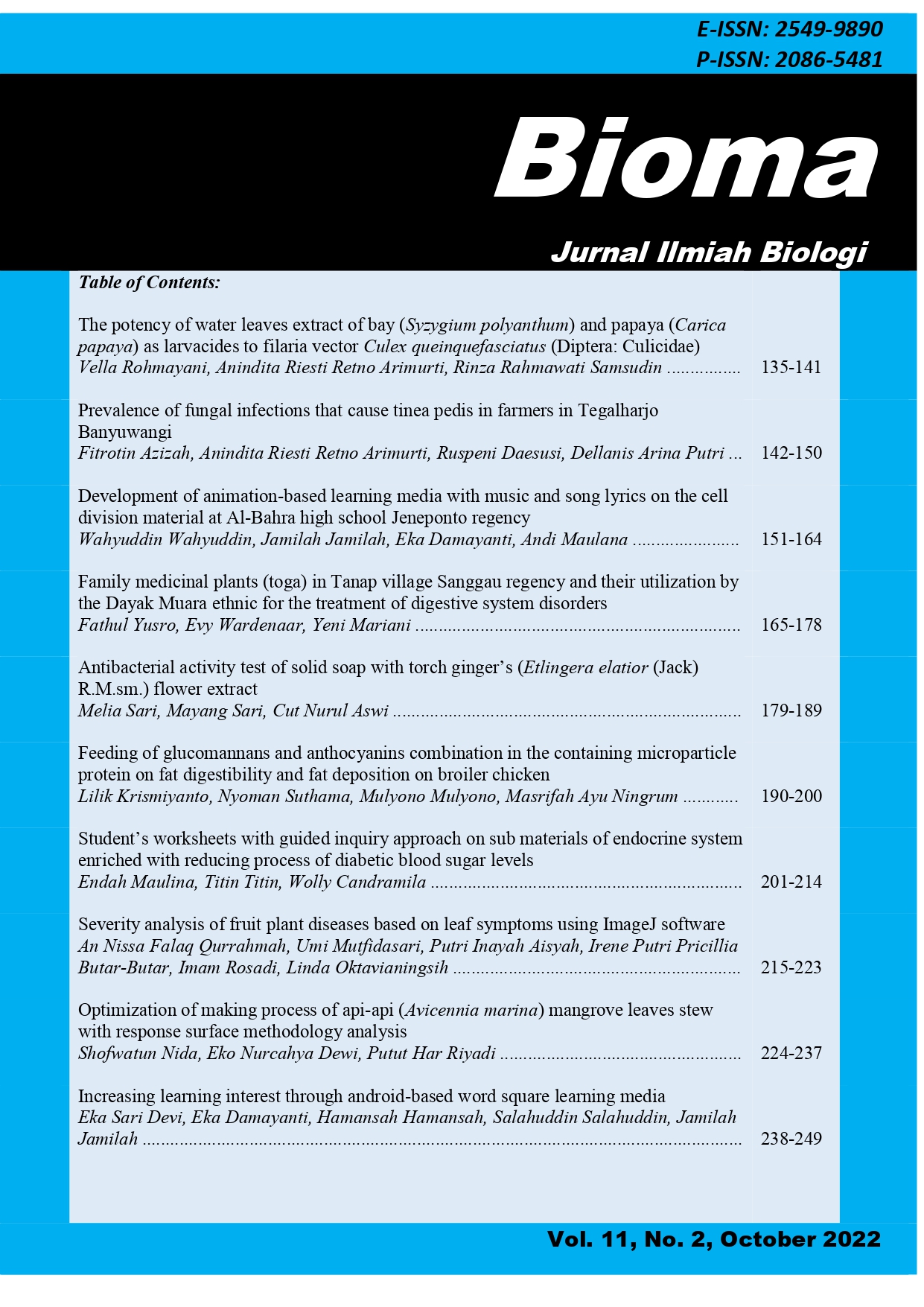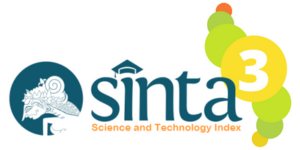T HELPER 17 (Th17) AND REGULATORY T (Treg) CELLS PROFILE IN TYPE-2 DIABETES MELLITUS (T2DM)
DOI:
https://doi.org/10.26877/bioma.v14i1.1208Keywords:
Type 2 DM, Metabolism, T Helper-17, T Regulator, Imbalance T cellAbstract
One of metabolic disorder disease is Type 2 Diabetes mellitus (DM), leading to increased glucose, cholesterol, and lipid levels in the blood. Type 2 DM results in insulin resistance within the body. Glycolysis, oxidative phosphorylation, and fatty acid are the three main metabolic pathways which provide energy for T cells. T cells will ploriferate, differentiate and become active into T Helper-17 and T regulator (Treg) cells because of these pathways. The profile of TH-17 cells and Treg cells in type 2 diabetes will be opposite in terms of the number of their populations caused by metabolic disorders in the body. Type 2 diabetes make an immunology response with increasingly number of TH-17 cells, while lack of Treg cells. Many studies have shown that diabetes mellitus as a metabolic disease effect populations of T Helper-17 and regulatory T cells. Glycolysis is the main energy metabolism becomes important factor that stimulate the proliferation and differentiation of Th-17 cells. The energy produced from this metabolism is in the form of ATP, which is the result of glucose synthesis using the Glucose transporter (GLUT). Glucose transporters (GLUT-1) are most dominantly expressed by Th-17 cells and Treg cells. Metabolic disorder causes an imbalance in the population of TH-17 cells with Treg cells. This review will explain the profiles of TH-17 and regulatory T cells in Diabetes mellitus and their relationship with body metabolism disease.
References
Abdel-Moneim A, Bakery HH, Allam G. (2018). The potential pathogenic role of IL-17/Th17 cells in both type 1 and type 2 diabetes mellitus. Biomedicine & Pharmacotherapy. May;101:287–92.
Cavallari, J. F., Denou, E., Foley, K. P., Khan, W. I., & Schertzer, J. D. (2016). Different Th17 immunity in gut, liver, and adipose tissues during obesity: the role of diet, genetics, and microbes. Gut Microbes, 7(1), 82–89. https://doi.org/10.1080/19490976.2015.1127481
Cluxton, D., Petrasca, A., Moran, B., & Fletcher, J. M. (2019). Differential Regulation of Human Treg and Th17 Cells by Fatty Acid Synthesis and Glycol-ysis. Frontiers in Immunology, 10. https://doi.org/10.3389/fimmu.2019.00115
Drescher HK, Bartsch LM, Weiskirchen S, Weiskirchen R. (2020 ). Intrahepatic TH17/TReg Cells in Homeostasis and Disease—It’s All About the Balance. Front Pharmacol. Oct 2;11.
Guerrero, J. A., Klysz, D. D., Chen, Y., Malipatlolla, M., Lone, J., Fowler, C., Stuani, L., May, A., Bashti, M., Xu, P., Huang, J., Michael, B., Contrepois, K., Dhingra, S., Fisher, C., Svensson, K. J., Davis, K. L., Kasowski, M., Feldman, S. A., … Mackall, C. L. (2024). GLUT1 overexpression in CAR-T cells induces metabolic reprogramming and enhances potency. Nature Communications, 15(1), 8658. https://doi.org/10.1038/s41467-024-52666-y
Guzmán-Flores J, Ramírez-Emiliano J, Pérez-Vázquez V, López-Briones S. (2020). Th17 and regulatory T cells in patients with different time of progression of type 2 diabetes mellitus. Central European Journal of Immunology. 45(1):29–36.
International Diabetes Federation Atlas. Indonesia Diabetes Report 2000-2045. 2021.
Kiernan K, MacIver NJ. (2020). A Novel Mechanism for Th17 Inflammation in Human Type 2 Diabetes Mellitus. Trends in Endocrinology & Metabolism. Jan;31(1):1–2.
Laila karomah.(2024). Proses glikolisis: tahapan & fungsinya. Mikrobio.id.
Lee, H. K. (2020). Fatty acid overload to compromised oxidative phosphoryla-tion activates inflammation in type 2 diabetes: Hidden beasts and how to find them. Journal of Diabetes Investigation, 11(2), 290–293. https://doi.org/10.1111/jdi.13172
Lee WI, Huang JL, Lin SJ, Yeh KW, Chen LC, Ou LS, et al. (2020). Lower T Regulatory and Th17 Cell Populations Predicted by RT-PCR-Amplified FOXP3 and RORγt Genes Are Not Rare in Patients With Primary Immunodeficiency Diseases. Front Immunol. Jun 25;11.
Lee-Ming Chuang. (2021). T helper 17 cells: A new actor on the stage of type 2 diabetes and aging? J Diabetes Investig. Mar 5;
Ma, X., Nan, F., Liang, H., Shu, P., Fan, X., Song, X., Hou, Y., & Zhang, D. (2022). Excessive intake of sugar: An accomplice of inflammation. Frontiers in Immunology, 13. https://doi.org/10.3389/fimmu.2022.988481
Machacek, M., Saunders, H., Zhang, Z., Tan, E. P., Li, J., Li, T., Villar, M. T., Artigues, A., Lydic, T., Cork, G., Slawson, C., & Fields, P. E. (2019). Elevated O-GlcNAcylation enhances pro-inflammatory Th17 function by altering the in-tracellular lipid microenvironment. Journal of Biological Chemistry, 294(22), 8973–8990. https://doi.org/10.1074/jbc.RA119.008373
Mayes PA B DA.(2003). Glycolysis and the oxidation of pyruvate. 26th ed. Mayes PA BDAG and the oxidation of pyruvate. IMRGD illustrated biochemistry, editor.
Neshat SY, Quiroz VM, Wang Y, Tamayo S, Doloff JC. (2021). Liver Disease: Induction, Progression, Immunological Mechanisms, and Therapeutic Interventions. Int J Mol Sci. Jun 24;22(13):6777.
Nicholas DA, Proctor EA, Agrawal M, Belkina AC, Van Nostrand SC, Panneerseelan-Bharath L, et al. (2019). Fatty Acid Metabolites Combine with Reduced β Oxidation to Activate Th17 Inflammation in Human Type 2 Diabetes. Cell Metab. Sep;30(3):447-461.e5.
Qiao Y chao, Shen J, He L, Hong X zhi, Tian F, Pan Y hong, et al. (2016). Changes of Regulatory T Cells and of Proinflammatory and Immunosuppressive Cytokines in Patients with Type 2 Diabetes Mellitus: A Systematic Review and Meta-Analysis. J Diabetes Res. 2016:1–1
Qin Y, Gao C, Luo J. (2022). Metabolism Characteristics of Th17 and Regulatory T Cells in Autoimmune Diseases. Front Immunol. Feb 25;13.
Sałkowska A, Karaś K, Karwaciak I, Walczak-Drzewiecka A, Krawczyk M, Sobalska-Kwapis M, et al.(2020). Identification of Novel Molecular Markers of Human Th17 Cells. Cells. Jul 3;9(7):1611.
Sun L, Fu J, Zhou Y. 2017). Metabolism Controls the Balance of Th17/T-Regulatory Cells. Front Immunol. Nov 27;8.
Tao L, Liu H, Gong Y. (2019). Role and mechanism of the Th17/Treg cell balance in the development and progression of insulin resistance. Mol Cell Biochem. Sep 19;459(1–2):183–8.
Wawman RE, Bartlett H, Oo YH. (2018). Regulatory T Cell Metabolism in the Hepatic Microenvironment. Front Immunol. Jan 8;8.
Wen, J., Liu, Q., Liu, M., Wang, B., Li, M., Wang, M., Shi, X., Liu, H., & Wu, J. (2021). Increasing Imbalance of Treg/Th17 Indicates More Severe Glucose Metabolism Dysfunction in Overweight/obese Patients. Archives of Medical Research, 52(3), 339–347. https://doi.org/10.1016/j.arcmed.2020.11.012
Xia C, Rao X, Zhong J. (2017). Role of T Lymphocytes in Type 2 Diabetes and Diabetes-Associated Inflammation. J Diabetes Res. 2017:1–6.
Zeng C, Shi X, Zhang B, Liu H, Zhang L, Ding W, et al. (2012). The imbalance of Th17/Th1/Tregs in patients with type 2 diabetes: relationship with metabolic factors and complications. J Mol Med. Feb 1;90(2):175–86.
Zhang H, Jiang Z, Zhang L. (2019). Dual effect of T helper cell 17 (Th17) and regulatory T cell (Treg) in liver pathological process: From occurrence to end stage of disease. Int Immunopharmacol. Apr;69:50–9.








